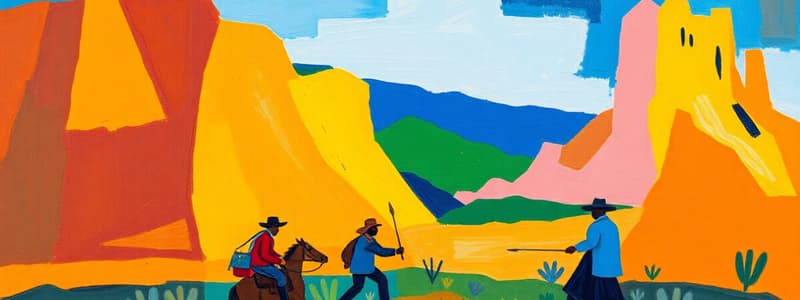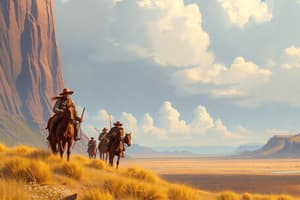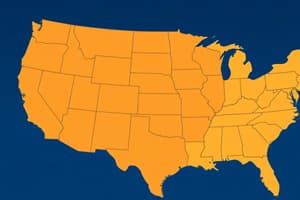Podcast
Questions and Answers
What was the primary reason for the Louisiana Purchase?
What was the primary reason for the Louisiana Purchase?
- To acquire New Orleans and support westward expansion (correct)
- To finance the American Revolutionary War
- To gain control of the Pacific coast
- To provide land for new settlers
Who played a significant role as a guide and interpreter during the Lewis and Clark expedition?
Who played a significant role as a guide and interpreter during the Lewis and Clark expedition?
- Brigham Young
- Meriwether Lewis
- Daniel Boone
- Sacagawea (correct)
What was the distance of the Oregon Trail?
What was the distance of the Oregon Trail?
- 4,000 miles
- 3,500 miles
- 1,000 miles
- 2,000 miles (correct)
What was the main idea conveyed by manifest destiny?
What was the main idea conveyed by manifest destiny?
What challenges did settlers face when traveling the Oregon Trail?
What challenges did settlers face when traveling the Oregon Trail?
Which trail led to Santa Fe, New Mexico?
Which trail led to Santa Fe, New Mexico?
What was one motivating factor for settlers on the Oregon Trail?
What was one motivating factor for settlers on the Oregon Trail?
Who was the French leader involved in the Louisiana Purchase?
Who was the French leader involved in the Louisiana Purchase?
What was the primary reason for the rapid growth of boomtowns?
What was the primary reason for the rapid growth of boomtowns?
What ended the Cattle Kingdom in the West?
What ended the Cattle Kingdom in the West?
Which event marked the official addition of California to the United States?
Which event marked the official addition of California to the United States?
What was the significant outcome of the Comstock Lode discovery?
What was the significant outcome of the Comstock Lode discovery?
What was the main purpose of the Pacific Railway Acts passed by Congress?
What was the main purpose of the Pacific Railway Acts passed by Congress?
What was a key factor contributing to the dangers faced by miners?
What was a key factor contributing to the dangers faced by miners?
What was a defining characteristic of the Cattle Kingdom?
What was a defining characteristic of the Cattle Kingdom?
What was the role of the Pony Express in American history?
What was the role of the Pony Express in American history?
What impact did the construction of railroads have on western migration?
What impact did the construction of railroads have on western migration?
What challenge did builders face while constructing the railroads?
What challenge did builders face while constructing the railroads?
What was the significance of the golden spike at Promontory, Utah?
What was the significance of the golden spike at Promontory, Utah?
What was the purpose of the Treaty of Fort Laramie?
What was the purpose of the Treaty of Fort Laramie?
What did the standard time system established by railroad companies do?
What did the standard time system established by railroad companies do?
What did most southern Plains Indians agree to under the Treaty of Medicine Lodge?
What did most southern Plains Indians agree to under the Treaty of Medicine Lodge?
What was a key factor that led to the conflict between settlers and Plains Indians?
What was a key factor that led to the conflict between settlers and Plains Indians?
Which event is associated with George Armstrong Custer?
Which event is associated with George Armstrong Custer?
What nickname was given to farmers who broke up tough turf on the Plains?
What nickname was given to farmers who broke up tough turf on the Plains?
Which crop was commonly grown using dry farming techniques on the Great Plains?
Which crop was commonly grown using dry farming techniques on the Great Plains?
What social organization did farmers form to protect their interests?
What social organization did farmers form to protect their interests?
Which act aimed to provide national regulations for trade but lacked enforcement?
Which act aimed to provide national regulations for trade but lacked enforcement?
What significant political party did the Farmers' Alliances form?
What significant political party did the Farmers' Alliances form?
Which event marked the settling of the Indian territory in what is now Oklahoma?
Which event marked the settling of the Indian territory in what is now Oklahoma?
By the early 1890s, what was the status of the frontier in the United States?
By the early 1890s, what was the status of the frontier in the United States?
Who supported many social causes and was a founder of Chico, California?
Who supported many social causes and was a founder of Chico, California?
What was the primary outcome of the Dawes General Allotment Act of 1887?
What was the primary outcome of the Dawes General Allotment Act of 1887?
Which Native American leader is associated with the resistance against the U.S. government among the Nez Percé?
Which Native American leader is associated with the resistance against the U.S. government among the Nez Percé?
What was the effect of the Massacre at Wounded Knee in 1890?
What was the effect of the Massacre at Wounded Knee in 1890?
What was the Long Walk experienced by the Navajo?
What was the Long Walk experienced by the Navajo?
What was the purpose of the Homestead Act of 1862?
What was the purpose of the Homestead Act of 1862?
Which group of people is referred to as Exodusters?
Which group of people is referred to as Exodusters?
Which event represented the Sioux's last major victory against U.S. forces?
Which event represented the Sioux's last major victory against U.S. forces?
What was the significance of the Morrill Act?
What was the significance of the Morrill Act?
Flashcards are hidden until you start studying
Study Notes
Westward Expansion
- The Louisiana Purchase in 1803 nearly doubled the size of the United States.
- The Lewis and Clark expedition explored the Louisiana Purchase, mapping the Missouri River and reaching the Pacific Ocean in 1805.
- Sacagawea, a Shoshone woman, served as a guide and interpreter for the Lewis and Clark expedition.
- Manifest destiny, the idea that the U.S. was destined to expand across the continent fueled westward expansion.
- The Oregon Trail and Santa Fe Trail were major routes for westward migration.
- The Oregon Trail, a 2,000-mile route starting in Independence, Missouri, and ending in Oregon, was challenging due to food shortages, bad weather, and difficult terrain.
- The Santa Fe Trail, which connected Independence, Missouri, to Santa Fe, New Mexico, was used for trading American goods for Mexican goods.
- The Mormons, led by Brigham Young, established their own westward trail to Utah.
- Mining discoveries, such as the Comstock Lode in Nevada brought a boom to the West.
- Mining boomtowns grew quickly and often disappeared when the mines closed.
- Mining was dangerous due to unsafe equipment, lung diseases from poor ventilation, explosions, cave-ins, and fires.
- The demand for beef led to the growth of the cattle industry, creating the Cattle Kingdom which stretched from Texas to Canada.
- Ranchers grazed huge herds on public land called the open range.
- The rise of barbed wire and shrinking public range ended the Cattle Kingdom.
- The Pony Express was used to carry messages across the 2,000-mile route, but was replaced by telegraph lines.
- The Transcontinental Railroad, completed in 1869, connected the East and West Coast, with work done by the Central Pacific and Union Pacific railroads.
- The construction of the Transcontinental Railroad was challenging due to geography and weather.
- The transcontinental railroad spurred economic growth, population increase in the West, and standardized time zones across the US.
Conflict with Native Americans
- The Treaty of Fort Laramie recognized Native American claims to the Great Plains but allowed for the construction of forts and travel across Native American lands.
- The discovery of gold in Colorado led to the U.S. government negotiating new treaties, relocating Native Americans to reservations.
- The Sioux, led by Crazy Horse, clashed with settlers and miners encroaching on their hunting grounds.
- The Treaty of Medicine Lodge in 1867 led to the relocation of most southern Plains Indians to reservations, except for the Comanche who continued to fight until 1875.
- The U.S. Army, including African American cavalry units known as Buffalo Soldiers, forced Native Americans onto reservations.
- The Battle of Little Bighorn in 1876, where Sioux forces defeated U.S. troops led by George Armstrong Custer, marked the Sioux's last major victory.
- The Massacre at Wounded Knee in 1890 saw U.S. troops kill about 150 Sioux.
- The Navajo, resisting reservations, faced raids by U.S. troops, and eventually surrendered, being forced to endure the "Long Walk" to a reservation.
- The Nez Perce, initially promised their Oregon land, were forced to relocate to a reservation in Oklahoma after the government demanded land.
- Chief Joseph led the Nez Perce in resisting relocation.
- Geronimo, leader of the Apache, fought against the U.S. government until 1886.
- The Ghost Dance movement, which predicted the arrival of paradise for Native Americans, was eventually suppressed after the Wounded Knee massacre.
- Sarah Winnemucca, a Paiute, advocated for reform of the reservation system.
- The Dawes General Allotment Act of 1887 aimed to assimilate Native Americans into American society, by allowing individual ownership of land, but ultimately took about two-thirds of Native American land.
Farming and Populism
- The Homestead Act of 1862 gave government land to farmers.
- The Morrill Act of 1862 gave federal land to states to fund colleges focused on agriculture and engineering.
- Thousands of African Americans, known as Exodusters, moved to Kansas and other areas in the West seeking better opportunities.
- Farmers on the Plains, known as sodbusters, faced challenges of breaking tough turf, which was made easier with new inventions.
- The Great Plains became known as the “breadbasket of the world” as farmers adopted dry farming techniques to grow hardy crops like red wheat.
- Women played a key role in settling the frontier, with figures like Annie Bidwell supporting social causes.
- Farmers formed communities, creating churches and schools.
- Overproduction led to lower prices and many farmers losing their farms, becoming tenant farmers.
- The National Grange, a social and educational organization for farmers, called for laws to regulate railroad rates.
- The Interstate Commerce Act of 1887 was passed to regulate trade, but it was difficult to enforce.
- Farmers’ Alliances formed the Populist Party, which advocated for government ownership of railroads, free silver, and labor regulation.
- William Jennings Bryan, the Populist Party candidate, lost the 1896 election, signaling the decline of the Farmers' Alliances and the Populist Party.
- The Oklahoma Land Rush in 1889, where settlers claimed over 11 million acres of former Indian land, marked the end of the frontier in the United States by the early 1890s.
Studying That Suits You
Use AI to generate personalized quizzes and flashcards to suit your learning preferences.




